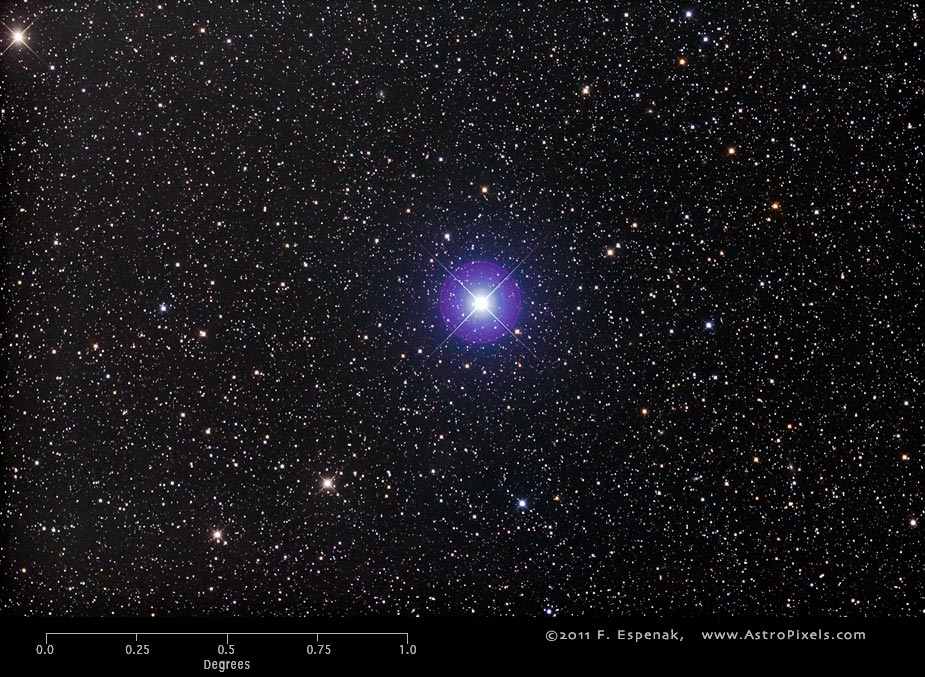Algol
Algol or Beta Persei (Bet Per) is the second brightest naked eye star in the constellation Perseus. With an apparent magnitude of 2.09, Algol is the 60th brightest star in the entire sky (see: 50 Brightest Stars ). Its absolute magnitude is -0.18 and its distance is 93 light years.The Equinox J2000 equatorial coordinates are RA = 03h 08m 10.1s, Dec = +40° 57' 20".
Algol has a spectral type of B8V, a surface temperature of 12,000° Kelvin and a luminosity 98 times the Sun. It has a mass of 3.6 solar masses and a diameter 2.3 times the Sun.
The image above shows the uncropped view of Algol (North is up) through the Takahashi E-180 Astrograph.
Algol's magnitude is usually near-constant at 2.1, but regularly dips to 3.4 every two days, 20 hours and 49 minutes. This was first recorded in 1667 but the periodic nature of its brightness variations was not recognized until 1783. In that year, British amateur astronomer John Goodricke proposed that the periodic variability was caused by a dark body passing in front of the star (or else that the star itself has a darker region that is periodically turned toward the Earth.) Consequently, Algol gives its name to its class of eclipsing variable, known as Algol variables.
Algol is actually a three-star system (Beta Persei A, B, and C) in which the large and bright primary Beta Persei A is regularly eclipsed by the dimmer Beta Persei B. This possible because the orbital plane of A and B coincidentally contains the Earth's line of sight. To be more precise, however, Algol is a triple-star system: the eclipsing binary pair is separated by only 0.062 AU, while the third star in the system (Algol C) is at an average distance of 2.69 AU from the pair and the mutual orbital period is 681 days (1.86 years). The total mass of the system is about 5.8 solar masses, and the mass ratios of A, B and C are about 4.5 : 1 : 2.
Studies of Algol led to the Algol paradox in theory of stellar evolution. Although components of a binary star form at the same time, and massive stars evolve much faster than the less massive ones, it was observed that the more massive component Algol A is still in the main sequence, while the less massive Algol B is a subgiant star at a later evolutionary stage. The paradox can be solved by mass transfer: when the more massive star became a subgiant, it filled its Roche lobe, and most of the mass was transferred to the other star, which is still in the main sequence. In some binaries similar to Algol, a gas flow can be seen.
This system also exhibits variable activity in the form of x-ray and radio flares. The former is thought to be caused by the magnetic fields of the AB components interacting with the mass transfer. The radio emissions may be created by magnetic cycles similar to sunspots, but, as the magnetic fields around these stars are up to ten times stronger than that of the Sun, these radio flares are more powerful and longer lasting.
Algol is 92.8 light years from Earth; however, about 7.3 million years ago it passed within 9.8 light years and its apparent magnitude was approximately −2.5, considerably brighter than Sirius is today. Because the total mass of the system is 5.8 solar masses, and despite the fairly large distance at closest approach, this may have been enough to perturb the Solar System's Oort cloud slightly and to increase the number of comets entering the inner Solar System. However, the actual increase in net cratering rate is believed to have been quite small.
The description above is based on the Algol entry in Wikipedia.For more information about Algol, see Stars (Jim Kaler).
Technical Details
- Object: Algol
- Other Names: Beta Persei, HR936, HD19356, HIP14576
- Object Type: bright star
- Object Data: Apparent Magnitude = 2.09, Absolute Magnitude = -0.18, distance = 93 light years
- Object Position (Equinox J2000): RA = 03h 08m 10.1s, Dec = +40° 57' 20", Constellation = Perseus
- Date/Time: 2011 Dec 29 at 06:36:08 UTC
- Location: Bifrost Astronomical Observatory, Portal, AZ
- Mount: Astro-Physics 1200GTO
- Telescope: Takahashi Epsilon 180 Hyperbolic Astrograph
- Camera: Canon EOS 550D (Rebel T2i) (modified with a Baader UV/IR filter)
- Field of View: 1.70° x 2.56° at 1.7 arc-sec/pixel (web version: 10.0 arc-sec/pixel)
- Exposure: 2 x 240s, f/2.8, ISO 800
- File Name: Algol-01w.jpg
- Processing (Adobe Camera Raw): Graduated Filter, Vignetting Correction, Noise Reduction, White Balance, Curves
- Processing (Photoshop CS5): Average Images, Curves, Noise Reduction
- Original Image Size: 3454 × 5179 pixels (17.9 MP); 11.5" x 17.3" @ 300 dpi
- Rights: Copyright 2011 by Fred Espenak. All Rights Reserved. See: Image Licensing.
